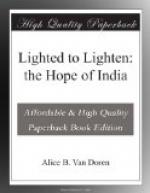Presently we fell into some casual talk, the inconsequent remarks common to chance acquaintance the world over. More intimate conversation followed, and before the end of the short journey together, I knew who Miss Paru was. The oldest daughter of a liberal Hindu lawyer on the Malabar Coast, she was performing the astounding feat of taking a medical course at the Men’s Government College in Madras, while systematically breaking her caste by living at the Y.W.C.A. I almost gasped with astonishment. “But what do your relatives say?” I asked. “Oh,” she replied, “my father is the head of his family and an influential man in our town. He does as he pleases and no one dares to object.”
That was twelve years ago. Yesterday for the second time I met my traveling companion of long ago. She is now Dr. Paru, assistant to Dr. Kugler in the big Guntur Women’s Hospital, with its hundred beds, managing alone its daily dispensary list of one hundred and fifty patients, and performing unaided such difficult major operations as a Caesarean section for a Brahman woman, of whom Dr. Kugler says, “The patient had made many visits to Hindu shrines, but the desire of her life, her child, was the result of an operation in a Mission Hospital. In our Hospital her living child was placed in her arms as a result of an operation performed by a Christian doctor.”
How did Dr. Paru, the Hindu medical student, develop into Dr. Paru, the Christian physician? I asked her and she told me, and her answers were a series of pictures as vivid as her own personality.
First, there was Paru in her West Coast Home, among the cocoanut palms and pepper vines of Malabar where the mountains come down to meet the sea and the sea greets the mountains in abundant rains. Over that Western sea once came the strange craft of Vasco di Gama, herald of a new race of invaders from the unknown West. Over the same sea to-day come men of many tongues and races, and Arab and African Negroes jostle by still in the bazaars of West Coast towns. Such was the setting of Paru’s home. During her childhood days certain visitors came to its door, Bible women with parts of the New Testament for sale, little paper-bound Gospels with covers of bright blue and red. The contents meant nothing to Paru then, but the colors were attractive, and for their sake she and her sister, childlike, bought, and after buying, because they were schoolgirls and the art of reading was new to them, read.
The best girls’ school in that Malabar town was a Roman Catholic convent. It was there that Paru’s education was given to her, and it was there that prayer, even in its cruder forms, entered into her experience. Religious teaching was not compulsory for non-Christian pupils, but, when the sisters and their Christian following gathered each morning for prayers, the doors were not shut and among other onlookers came Paru, morning after morning, drawn partly by curiosity, partly by a sense of being left out. Never in all her years in that school did the Hindu child join in the Christian service, but at home, when father and mother were not about, she gathered her sister and younger brothers into a corner and taught them in childish words to tell their wants and hopes and fears to the Father in Heaven.




